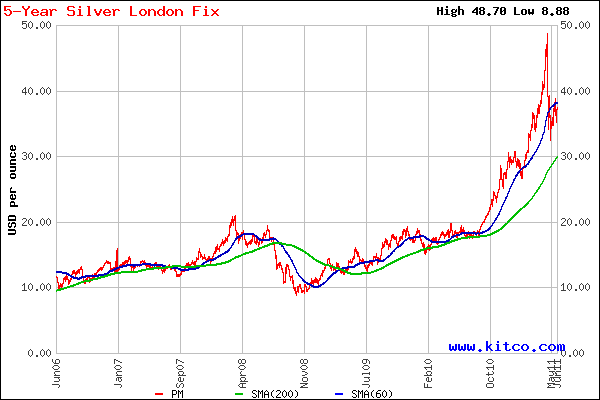 The recent sharp price correction in silver has left many wondering how long it will take before silver recovers and moves on to new highs.
The recent sharp price correction in silver has left many wondering how long it will take before silver recovers and moves on to new highs.
Since hitting its April 28th peak price of $48.70 (as measured by the closing London PM Fix Price) silver declined to a low of $32.50 on May 12, for a loss of $16.20 per ounce or 33.3%.
Looking at the last major price correction in silver which occurred in 2008, we find that the 2011 correction is far less severe. Silver hit a high of $20.92 per ounce on March 17, 2008 and then proceeded to consolidate until late July. In August 2008, the financial crisis entered its worst phase and asset classes of every type were driven lower by panic selling and forced liquidation.
On October 24, 2008, silver reached its low at $8.88 and then began a recovery phase, closing at $10.79 per ounce on December 31, 2008. From the March 2008 high to the October 2008 low, silver dropped by a shocking 57.6%.
From the lows of 2008, silver never looked back and rose to higher highs throughout 2009, closing the year at $16.99 per ounce. The upward trend continued during 2010 and silver finally closed above the March 2008 high in September of 2010. Silver continued to gain momentum through the final three months of 2010 and closed at $30.63 per ounce on December 31, 2010.
It took two and a half years (30 months) for silver to fully recover from the price correction of 2008. For a variety of reasons, the recovery to new highs in silver from the May 2011 sell off should be much shorter.
Authorities were unprepared for the financial meltdown of 2008 and were completely caught off guard as to the severity of the crisis. In February 2008, just prior to the collapse of major banking institutions, Fed Chairman Bernanke said “I expect there will be some failures. I don’t anticipate any serious problems of that sort among the large internationally active banks that make up a very substantial part of our banking system.” It was only months later that almost every large bank in the country was on the verge of failing.
At mid year 2008, the highest ranking financial officials in the U.S. Government could still not see the financial meltdown that was imminent. In June 2008, Fed Chairman Bernanke said the danger of the economy falling into a “substantial downturn” appears to have waned. Literally days later, the global financial system was on the verge of collapse.
The system has not been fixed since 2008, despite the expenditure of trillions of dollars by governments and central banks to restore financial stability. The attempt to solve the problem of too much debt by extending additional credit has failed – the cure cannot be the same as the disease.
Every economic indicator is now pointing towards another global slowdown and this time the insolvency threats extend to numerous sovereign entities which will make containment of a financial crisis more difficult. Above all else, the world of paper currencies relies upon confidence. Who is going to be confident that insolvent sovereign States can come to the rescue in Financial Crisis II?
Global authorities do not want to risk a replay of 2008 when the entire financial system came within a heartbeat of collapsing. At the first signs of a potential financial crisis, central banks will use the only tool they have left and flood the world with printing press money. The alternative is to risk a full blown Financial Crisis II which ultimately may not be containable. As the prospects for massive quantitative easing intensify, investors seeking to preserve their wealth will turn to precious metals driving prices sharply higher.
Looking back a year from now, investors will realize in hindsight that the price dip of May 2011 represented the best buying opportunity in silver since October 2008.
